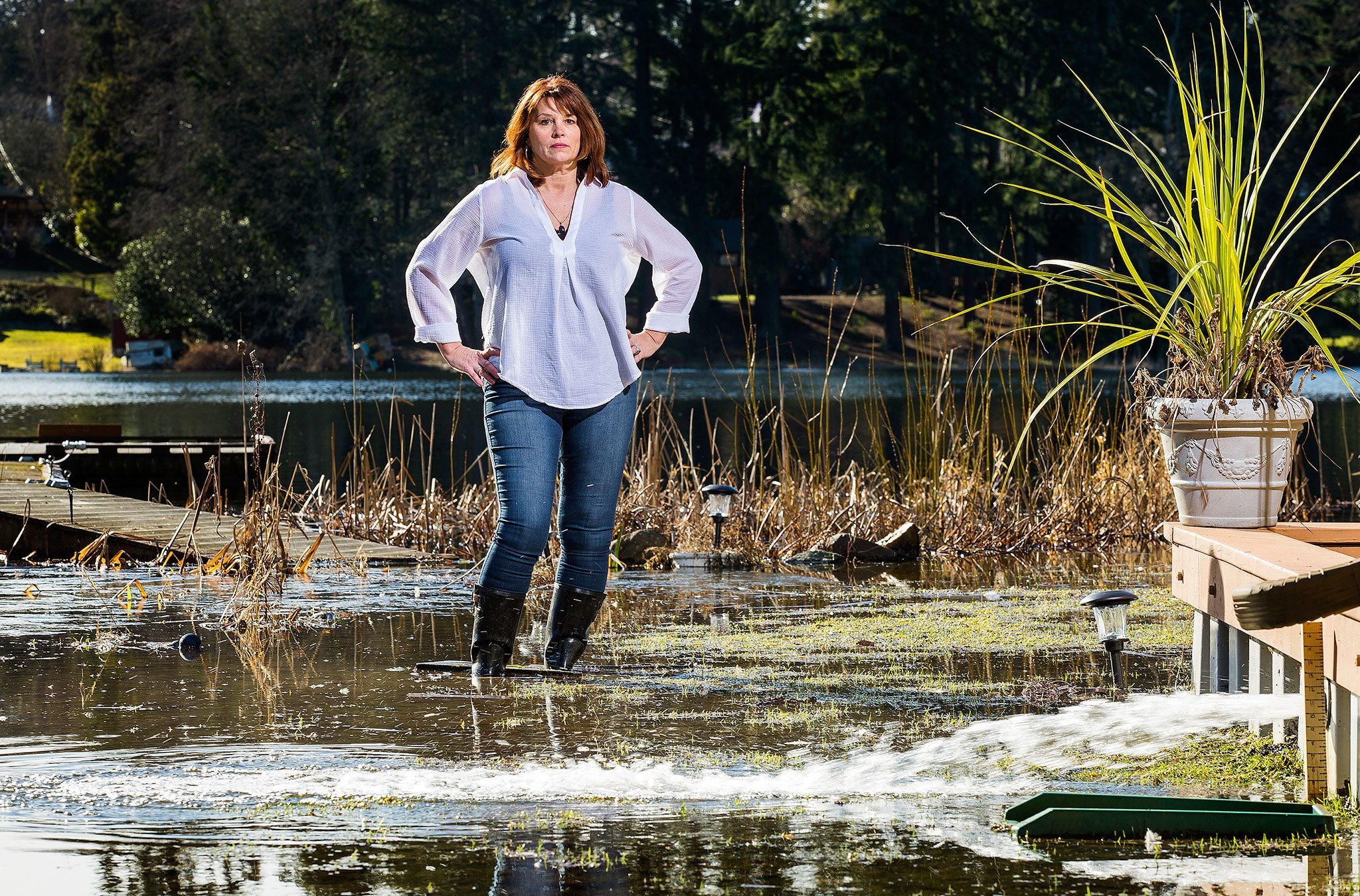LYNNWOOD — When Debbie Bly-Olsen and her husband, Ryan, moved into their lakefront home during the dry month of June, there was no sign of what lay ahead.
Like many others drawn to Lake Serene, they would soon find themselves too close for comfort to the beautiful aquatic landscape. Last month, the lake level rose to submerge docks, inundate back yards and threaten basements. Since early January at Bly-Olsen’s house, they have had two sump pumps going nonstop and a line of sandbags wrapped in plastic around the ground floor. That’s in addition to a knee-high wall the previous owner installed.
“If we get rain this weekend, it’s just going to come up,” she said. “I don’t want to fish from my living room.”
The lake north of Lynnwood, west of Highway 99, saw a similar change in 2014. That came after a long stretch of torrential rainfall. What troubles Bly-Olsen and her neighbors is that the lake rose during wet weather earlier this winter. Yet it’s remained high, despite weeks of unseasonably dry skies.
Snohomish County surface water staff have been monitoring lake levels daily since homeowners alerted them to the problem.
“We found that the lake levels did rise when it rained, but they’ve been receding slowly,” said Will Hall, who directs the county’s Surface Water Management Division. “That leads us to suspect that there’s a problem.”
The lake level rose 5 inches after a rainstorm in early January. That’s about 6 inches below the record high level in March 2014 and close to the previous high level in 1997.
That problem likely involves a blockage in the lake’s outflow pipe near the boat launch on the lake’s west end. The pipe appears to be in worse shape than in 2014.
It’s unlikely county crews could swoop in for a quick fix.
Before the recent rise in lake levels, county drainage staff had been looking for solutions. The county hosted a neighborhood meeting in April.
The pipe lies mostly on private property, Hall noted, and the county doesn’t generally get involved fixing private drainage problems — “until it gets to the point of impacting public infrastructure.”
Flooding could damage Serene Way, a county road. County officials say they’d be willing to team up on a solution, if lakeside property owners pony up a few hundred dollars per year each to help pay for the work.
County engineers have drawn up plans for a new piping system at an estimated cost of $850,000. The county would cover about two-thirds of that, with homeowners picking up the rest. That would leave 95 affected property owners paying an average of $340 in extra yearly stormwater fees.
Property owners around four lakes in Snohomish County pay additional surface-water charges to handle problems such as pollution and invasive aquatic plants. That includes Lakes Stevens, Ketchum, Goodwin and Shoecraft.
The County Council would have to approve any such arrangement at Lake Serene. Before starting construction, the county would need to secure local, state and federal permits. It’s unclear how long that would take.
Another option would be leaving it up to individual lakefront homeowners to fend for themselves. Alternatively, the neighborhood could opt to pay collectively for the drainage upgrade through private funds, similar to what a homeowners association might do.
The county was preparing to send out a survey about which option affected homeowners would prefer.
Marc Bhend said things look as bad from home on Lake Serene as they did three years ago. He’s spent thousands of dollars to redo landscaping from past floods, something he expects to do again come spring.
“The lake should have receded, but it hasn’t,” Bhend said.
Bhend, who has owned his home for nearly 40 years, said problems with lake levels have gotten worse of late. He blames it on urban development to all sides. County officials, in his view, should have done a better job managing the added storm runoff from all the new roofs, driveways and other developed surfaces.
“It really seems to me the county is clearly responsible for what is happening at the lake,” he said.
Hall is convinced otherwise. He said the trouble is tied to the outflow pipe’s condition. Recent development might have changed the rate at which stormwater flows into the lake, but it shouldn’t affect the amount of water that winds up there. The size of the watershed hasn’t changed.
“Even when it was forest, the rain that fell on that hillside would still have flowed into Lake Serene,” he said.
At Bly-Olsen’s house pumps spout water every few minutes. She looked wearily at the partial moat that’s formed around her house. Two pumps have burnt out already keeping it at bay.
“It’s so peaceful, but that peace is slowly ebbing away with anxiety,” she said. “We’ve heard stories about normal flooding, but this is definitely not normal.”
Noah Haglund: 425-339-3465; nhaglund@heraldnet.com. Twitter: @NWhaglund.
Talk to us
> Give us your news tips.
> Send us a letter to the editor.
> More Herald contact information.

























